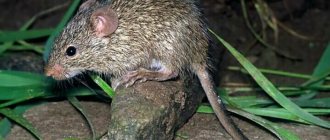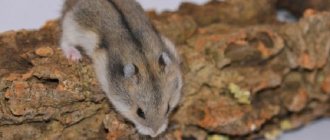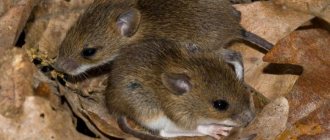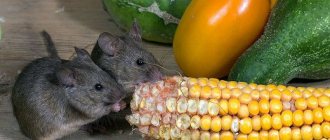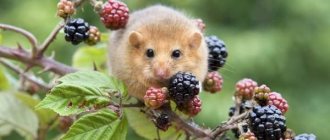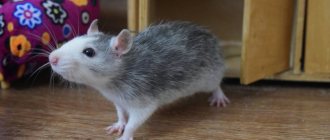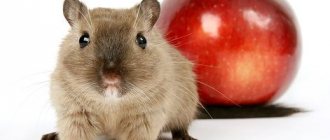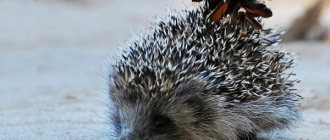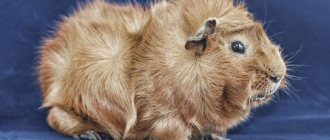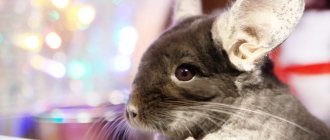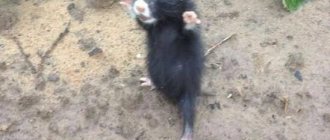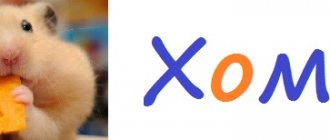Mice are nimble and small rodents, whose appearance and specific habits are known to everyone.
Most species of these funny mammals belong to the group of synanthropic animals, that is, they choose areas near human habitation as their habitat, which facilitates access to food sources and heat.
Mice are distributed throughout the entire planet, with the exception of high mountain areas and the Far North. Decorative species of animals have been bred that require home maintenance and care.
Where does the mouse live?
The distribution range of mice covers almost all climatic zones, zones and continents of the globe. Mouse representatives can be found in tropical thickets, coniferous or deciduous forests, steppes and deserts, on mountain slopes or in swampy areas. Mice also live in people's homes.
Mice can build nests from grass stems, occupy abandoned burrows, or dig complex systems of underground passages. Unlike species that live in swamps, mountain, steppe and forest mice swim poorly.
Is it possible to take a wild mouse from the street and make it a pet?
A rodent that is accustomed to living in its environment is difficult to adapt to in the home. In essence, the new environment creates constant stress for the animal.
It is necessary to recreate the most comfortable living conditions for the animal . Given the characteristics of the nervous system and small brain, the animal does not adapt and train well.
It is also necessary to remember that street rodents can carry infectious diseases that are dangerous to humans.
Although there are exceptional cases when a person took an animal into a home with a successful outcome.
Mouse - description
These small rodents are distributed throughout the entire earth, excluding the extreme northern and high-mountain regions. The closest relatives of mice are jerboas, mole rats, hamsters and dormice. And more distantly related are rats, chinchillas, porcupines, beavers, and guinea pigs. In total, the Mouse subfamily includes 121 genera and more than 300 species.
The mouse is a small animal with an elongated and pointed muzzle, large round ears and bulging beady eyes. A long, hairless or slightly pubescent tail is a distinctive feature of the animal. The limbs, which are not the same in length, are adapted for digging and moving along vertical and horizontal surfaces. The body length of a rodent can vary from 3 to 20 cm, weight - from 15 to 50 g.
Mice have a special bite. On the lower and upper jaws the animal has 2 chisel-shaped teeth, which are continuously growing. Rodents are forced to constantly grind them down, which is why their incisors are very sharp.
Animals from the Mouse family have good eyesight and can distinguish between red and yellow shades. The usual body temperature of these rodents ranges from 37.5 to 39⁰C. The maximum lifespan of mice is 4 years.
What does it look like
Mice of individual species look different, but there are some features that are common to all representatives of this subfamily, for example:
- Large soft ears, oval in shape.
- Big bulging eyes.
- Oblong body.
- Tail bare or covered with sparse hairs.
- Different sizes of front and rear limbs. The front ones are much shorter.
- The anatomy of mice involves long incisors that grow throughout life.
The body length of representatives of the mouse order varies from eight to twelve centimeters in length. The size of some species can reach fifteen centimeters.
Types of mice
The mouse family includes 4 subfamilies, 147 genera and 701 species, the most common of which are:
- Maned wolf
- Nettle
- Elk
- 100 facts about bears
- Jungle animals
- Saber-toothed tiger
- The field mouse (lat. Apodemus agrarius) reaches a size of 12.5 cm, not counting the tail, which can be up to 9 cm long. The color of the back of the mouse is gray, with a slight yellowish-brown tint and a dark stripe running along the ridge, and the belly is light gray color. The habitat of the field mouse includes Germany, Hungary, Switzerland, Poland, Bulgaria, the southern part of Western Siberia and Primorye, Mongolia, Taiwan, the Korean Peninsula and certain territories of China. This species of mice lives in wide meadows, in dense thickets of bushes, city gardens and parks, and makes a refuge both in burrows and in any natural shelters. In flooded areas it builds nests on bushes. Depending on the season, the diet may consist of seeds, berries, green parts of plants and various insects. The field mouse is the main pest of grain crops.
- The yellow-necked mouse (lat. Apodemus flavicollis) has a reddish-gray color and a light belly (sometimes with a small spot of yellow). The body size of adult individuals reaches 10-13 cm, the tail has approximately the same length. The mouse weighs about 50 grams. This type of mouse is widespread in the forests of Russia, Belarus, Moldova, Bulgaria, Ukraine, the Caucasus, the northern provinces of China and Altai. Yellow-throated mice live on open edges in hollow trees or dug holes, but they can also live in rocky areas. Their diet includes both plant and animal foods. By eating young shoots of fruit trees, they cause significant harm to nurseries.
- The grass mouse (Nilotic grass mouse) (lat. Arvicanthis niloticus) is one of the largest representatives of the mouse family and can reach 19 cm in length, and with the tail - 35 cm. The weight of individual large individuals exceeds 100 g. The fur of the back and sides has dark gray or grayish-brown in color with individual hard and spiny bristles of a darker shade. The belly color is light gray. This type of mouse is most common in African countries, where they live in bushes, forests and savannas. As a refuge, grass mice choose abandoned termite mounds or dig holes on their own, but on occasion they can enter human habitation. The basis of the diet of mice is plant food.
- The baby mouse (lat. Micromys minutus) is one of the smallest rodents in the world. The body length of an adult animal does not exceed 7 cm, the tail - 6.5 cm, and the weight of the baby does not exceed 10 g. The back and sides are plain and have a reddish-brown or brown color, in contrast to the light gray, almost white belly. The muzzle of baby mice is short and blunt, with small ears. The distribution area of this species of mice stretches from west to east from the northwestern provinces of Spain to Korea and Japan, in the south to Kazakhstan, China and the northern regions of Mongolia. The mouse lives in forest and forest-steppe zones, in meadows with tall grass. In the summer, mice use nests made in the grass as shelter, and overwinter in burrows, haystacks, and human residential or outbuildings. The basis of the diet of baby mice is the seeds of cereals and legumes, as well as small insects. They often settle near granaries, causing enormous damage to agriculture.
- The house mouse (lat. Mus musculus) is the most widespread species of the rodent family on the planet. The body length of an adult mouse does not exceed 9.5 cm, and together with the tail - 15 cm. The weight of the mouse is 12-30 g. The color of the fur on the sides and back is gray with a brown tint, and on the abdomen from light gray to white. Individuals living in desert areas are sandy in color. The mouse's muzzle is sharp with small rounded ears. The distribution range of this species of mice does not include only the territory of the Far North, Antarctica and high mountain regions. House mice live in all types of landscapes and natural areas, and very often penetrate into human outbuildings and residential buildings. In natural conditions, they dig minks on their own, although they can also occupy homes abandoned by other rodents. They feed on seeds and juicy green parts of plants, and once they enter a person’s home, they eat everything they can get their teeth into – from bread and sausages to paraffin candles.
- The striped mouse (lat. Lemniscomys striatus) is a small rodent: the length of the body is 10-15 cm, intermittent stripes of light colors are visible along the back and along the sides. Under natural conditions, striped mice rarely live more than 6-7 months; in captivity they live two to three times longer. The menu of these individuals includes mainly plant “dishes”: root vegetables, soft seeds, juicy fruits, and occasionally small insects.
- The spiny mouse (Acomys) (lat. Acomys) is a rather cute representative of the mouse family, the owner of huge eyes and equally large ears. The size of the spiny mouse, including its tail, is 13-26 cm; the back of the animal is covered with thin spines, like a regular hedgehog. An amazing feature of these animals is regeneration: when in danger, the mouse is able to shed a piece of skin, leaving the attacker bewildered. The skin is quickly restored without damage to the individual. The spiny mouse lives in Asian countries and is found in Cyprus and Africa. Its diet relies on plant foods; this animal is often kept as a pet.
Character and lifestyle
Since mice live in areas with different climates, they need to adapt to different living conditions, and mice have not one, but several ways of adaptation:
- Active throughout the year. These animals make provisions for a rainy day all year round.
- But they can do without supplies if their place of residence is shops, residential buildings or food warehouses;
- Seasonal migrations - closer to winter, mice migrate from their natural habitat to places that are located near human habitation, and in the spring they move back;
- In order to maintain optimal body temperature in hot or cold seasons, the mouse must move too much, and for this it absorbs a lot of food.
The entire life cycle of this rodent depends on body temperature. If a mouse does not move in winter, it will freeze, and if it does not move in summer, during the hot period of the year, then the body will produce excess heat, which can kill the animal.
Therefore, the entire life activity of a mouse consists of the fact that it moves - it gets food for itself, eats, engages in mating games and raises offspring. The main movement in mice begins with the onset of darkness. It is then that they begin to look for food, set up their home, that is, they dig holes, and protect their area from their fellow tribesmen.
Do not think that a tiny mouse is a cowardly creature. In the process of protecting her home, she can attack an animal that is much larger than the mouse itself. If a mouse lives in a place where there is constant twilight, then it is more active, and it has to rest less and in periods.
But if there are people constantly in the habitat of mice, then the mice are not too “shy” - when the room is quiet, they can go out in search of food during the daytime. However, if a mouse is kept as a pet, then it has to adapt to the owner's regime. These animals live in groups, because a single individual will not be able to make large enough reserves, find food and detect danger in time.
True, life in a mouse family is not always cloudless - serious conflicts also occur, which, as a rule, break out due to lack of food. Females are much calmer than males; they even often breed offspring together and jointly raise them.
A mouse is a wild animal and obeys the laws of its family. Its activity also depends on what place a particular animal occupies in this family. It is the leader who determines the periods of wakefulness and rest for his subordinates. In addition, weaker mice try to dig holes and get food for themselves while the head of the family is resting, so as not to catch his eye once again.
How mice behave in their natural environment
In order for rodents to maintain a constant body temperature, they need to be active in winter and summer, day and night. Gluttony and fussiness for mice are characteristic traits that help them survive and leave offspring.
In the fall, animals begin collecting provisions in a burrow or on the surface of the ground, where the “warehouse” is camouflaged with earth. And if in the off-season rodents are awake at night and sleep during the day, then in winter they remain active around the clock. In spring and autumn, when there is no shortage of food and no temperature fluctuations, mice actively reproduce.
Mice live in large families, since together it is easier for them to defend themselves, get food, build homes, and raise offspring. In a mouse pack there is a leader who maintains order in the group. Female mice are peaceful. But young males do not always put up with their subordinate position. Stomping with its hind legs and aggressive tail strikes indicate the animal’s intention to conquer the “throne.” Inter-family clashes can lead to the disintegration of the pack.
Mice spend most of their time in burrows, raising offspring, escaping danger, storing food, or resting after eating it. The maximum depth of the burrow is 70 cm, and the total length of the passages can reach 20 m. Some species of mice build nests in thickets of tall grasses (little mouse) or live in tree roots and old stumps (forest mouse).
Minks can be temporary or permanent, and the latter can be summer or winter. Temporary housing for animals is simply planned. The permanent mouse hole has a spacious nesting chamber and several entrances. In summer burrows where rodents give birth, bedding is created from fluff, blades of grass, shavings and feathers. And in winter, a pantry is set up for food supplies.
What is the difference between a wild mouse and a decorative one?
Over time, scientists have developed other hybrids, characterized by different colors and lengths of fur or no fur at all; size, habits and character.
The most important thing that distinguishes a decorative creature from a street one is the absence of viruses and bacteria that are infectious to humans, i.e. biological safety and cleanliness of the animal .
Another important element is the gentle, trainable nature of the pet, i.e. adaptation to life among people.
Outdoor mice can be aggressive and difficult to train.
Scientists have bred different species of mice that are classified as ornamental rodents and are suitable for contact with the population.
Reference . Diseases carried by street mice:
Nutritional features of mice
Peering at damaged containers, furniture, household items, and walls of the room, one gets the impression that the mouse is omnivorous. It chews on everything it comes across on the go, even if it has no nutritional value.
Such a brutal appetite is explained by several aspects of her life:
- The mouse is forced to constantly grind down its front teeth. Chews hard objects.
- The animal has an accelerated metabolism. Food is quickly digested, and due to high mobility, energy is instantly consumed. On average, a rodent should eat 5 g of food and drink 20 ml of water per day.
- The mouse has this peculiarity - it tastes everything new and unknown.
Regarding food preferences, the mouse is a predator. But he prefers plant foods. Replenishment of proteins is carried out by eating worms, insects, eggs, and chicks. The herbivorous creature eats helpless birds with great appetite and steals eggs from nests. Then he arranges a home for himself in this place.
A herbivorous mouse gnaws seeds, the green part of plants. If there is a lack of fluid, he eats berries, fruits, and vegetables. Prefers grains, cereals, seeds, flour.
Care and maintenance of domestic mice
There is nothing difficult about caring for and maintaining decorative mice, even for a child. The conditions of detention should be as follows:
Attention! It is important to choose the right place for a house mouse to live. The cage should not be located near heating devices or in direct sunlight. Overheating is dangerous for the life of a rodent.
Cage and filler
Before buying a cage, you need to decide how many mice will live there. For a family of 3-4 individuals, a dwelling measuring 60x50 cm is suitable. The height can be any, but not less than 40 cm. For one house mouse, a cage with dimensions of 40x30 cm is used.
Preference is given to designs made of metal gratings with a plastic removable tray. It’s good if it has high sides, then the filler won’t spill out. The door must close securely, otherwise the decorative mice will escape.
A thick layer of wood shavings is poured onto the bottom - at least 3-4 cm. Only natural materials can be used as bedding - pressed sawdust, crushed corn cobs. Cotton wool, rags, paper are not the best option, as they do not hold back unpleasant odors and quickly get wet.
Interior design of a mouse's home
It is recommended that pet mice have a resting house. You can make it yourself from scrap materials or buy it ready-made at a pet store. A little filler is poured inside so that mice can burrow into it when they are cold or scared.
In addition to the house, you will need a feeder and water bowl, as well as a running wheel to increase physical activity. It is better to give preference to a solid structure without holes. The tail can get stuck there while running, which can lead to injury. If there is enough space in the cage, it is worth placing pipes, tunnels and ladders inside. With their help, it is convenient to connect the first level with the second.
Hygiene
Cleaning the cage of a decorative rodent is done as the litter becomes dirty. If there is only one house mouse living there, the procedure is carried out once every 5-7 days, if there are several, more often. The old filler is thrown away and new filler is added. Every time during cleaning, all equipment is washed - drinking bowl, feeder, pipes and wheel. It is better to clean the tray with a soda solution and scald it with boiling water.
Attention! An unpleasant smell in the cage appears only because the owner of a pet rodent rarely cleans the cage. This is also why mouse fur stinks.
The fur of a house mouse also needs to be looked after. It becomes contaminated with feces and urine, and pieces of food stick to it. Even if the fur smells bad and looks untidy, the decorative rodent should not be bathed. Mice cannot swim and are very afraid of water, unlike domestic rats. Dirty fur can be cleaned in other ways - with a toothbrush, a damp cotton pad or a piece of soft cloth.
Bathing a house mouse in water is allowed in exceptional cases when the contamination cannot be removed in any other way or is life-threatening. To wash your pet you will need a deep bowl. No more than 2 cm of water is taken into it. The fur is gently wetted by hand, then detergent for rodents is applied, lathered and rinsed. After thorough rinsing, the pet mouse is wrapped in a towel and held in your arms for as long as possible so that it does not catch a cold.
Taming of ornamental rodents
A house mouse is easier to tame than a hamster. The main thing in this matter is consistency and regularity of communication.
After purchasing the decorative rodent, leave it alone for a day or two. During this time, he will adapt, inspect and sniff his new home. Next, you can begin to gradually tame the mouse:
To prevent a house mouse from going wild, you need to regularly communicate with it. If you don't pick it up for a long time, it will quickly wean itself off its owner.
Important! House mice love company. If an ornamental rodent lives alone in a cage, it needs to be given more attention.
Reproduction in mice
The mouse is a polygamous animal. In nature, one male fertilizes from 2 to 12 females. Over 12 months, mice have from 3 to 8 litters. The female reaches sexual maturity 10 weeks after birth. At this time, she begins to go into heat, which lasts 5 days and is expressed in special behavior.
If after coating the female fails to become pregnant, a new estrus occurs within a week. If fertilization is successful, the female animal is expected to give birth in 17-24 days. There are from 3 to 9 cubs in one litter. Female mice give birth at night. Babies, when born, are unable to move, hear or see. They have no hair and their size ranges from 2 to 3 cm.
Mice develop rapidly:
- 3 days – fluff appears on the body;
- Day 5 – the cubs begin to hear;
- Day 7 – the animal’s body weight doubles;
- Day 14 – palpebral fissures appear;
- Day 19 – the mice begin to eat on their own;
- 25 days – the length of the body reaches 500 mm (the tail is 15-20 mm shorter) and the mouse is already sexually mature.
Decorative mice develop a little slower. It is recommended to mate them no more than 2-3 times a year. Repeated births exhaust the female, and each subsequent offspring becomes weaker.
Progress of the lesson
Educator: Guys, today I was going to the children in the younger group to tell them about domestic and wild animals , but all the illustrations that I carried for them fell and got mixed up. And now I don’t know where are the domestic animals and where are the wild ones? Can you help me figure it out? Then place wild animals and domestic animals .
/Children complete the task/
Tell us which illustrations show wild animals and which ones show domestic animals .
What other domestic (wild)
animals do you know ?
Bottom line: pets live with people , people create conditions for their life, feed them, build housing, and treat them. All domestic animals benefit humans on the farm (they provide food: milk, meat, wool; they are used in work: horses, camels.)
Educator: And now the difficult task is to determine: what kind of animal , domestic or wild ? Where does the mouse live? Who is she afraid of? Is the person afraid? Does a person care about her? Does it benefit humans?
Conclusion: the house mouse is not a domestic animal , but a wild one; it has adapted to live next to a person, in his house.
The teacher invites the children to play the game “I know birds, animals, fish”
.
Children stand in a circle. The leader stands in a circle and says: “I know birds.” Then he throws the ball to the child, who must name the birds. Animals and fish are called similarly. (You cannot name the same bird, fish, or animal.)
3. The teacher invites the children to the table for an experiment.
– What do you think will happen if you and I don’t water indoor plants (They will dry out without water, the leaves will wither)
Water is essential for plant life and growth. Let's watch with you. Let's take two peas. We place one of them on a saucer in a wet cotton wool, and the second on another saucer in a dry cotton wool. We'll put the saucers on the windowsill. Which pea will sprout and which will not? Why? As a result of this observation, children will clearly see the role of water in the development and growth of plants.
Lesson summary “Visiting Pets” “Visiting Pets” Integrated educational areas: social-communicative cognitive.
Talk about pets to develop creative imagination. learn to find signs of similarities between pets and objects located around them. develop logical.
Summary of direct educational activities “Autumn gatherings. Conversation about pets" Program content. To consolidate children's knowledge about seasonal changes in nature. Expand your understanding of the life of pets in winter.
GCD summary for expanding children's knowledge about domestic animals GCD summary for ecology in the middle group "Pets" Goal: to expand children's knowledge about domestic animals and their cubs. Software.
Leisure scenario “Journey to the land of pets” Purpose: To consolidate children’s knowledge about pets (they live with a person, a person loves his helpers, takes care of them - feeds, cares for,...
"Autumn Gatherings" Lesson-conversation about pets Objectives: = consolidate children's knowledge about pets; = develop the ability to identify signs of similarity and difference between animals; = recognize animals.
GCD plan in the middle group “World of Pets” (part I) part 2 GCD plan middle group. Topic of the week: “The World of Pets” Final event: “Plot-role-playing game “Treating Pets.”
Project “World of Pets” Project type: research and creative. Project participants: children of the second junior group, teachers, music director, parents.
Ecological project to form an idea about domestic animals Ecological project to form an idea about domestic animals Topic: “Visiting Grandma Nyura” (junior group) Author: Votyakova.
Source
Enemies of mice
The mouse is a key link in the food chain of many ecosystems. Many wild animals depend on the existence of this small rodent. For mice living in the forest, the main enemies are foxes, martens, arctic foxes, ferrets, stoats, weasels, lynxes and even wolves. Predators easily tear apart burrows and can eat up to 30 small animals a day.
Mice are the main food for snakes and large lizards. Reptiles such as boas, pythons, vipers, and radiant snakes swallow their prey whole. During the hunt, the snake freezes, and then suddenly attacks the victim, biting it with poisonous teeth, and then waits for the animal to become motionless.
There is also danger lurking for mice from above. Among birds there are predators that differ in the power of their beaks, visual acuity and hearing. These are owls, buzzards, hawks, eagles, owls, kites. They hunt during the day or night, making swift attacks from the air.
Mice are used in nearly 75% of animal research procedures
The following are approximate figures for the use of model organisms in laboratory research:
- rats, mice and other rodents, universal laboratory species – 83.3%;
- fish, amphibians, reptiles and birds – 15%;
- sheep, cows, pigs and other large mammals – 1.5%;
- dogs and cats bred for research; the use of stray pets is unacceptable – 0.1%;
- Primates, mainly monkeys and macaques – 0.1%.
Photo: Genetic Engineering and Biotechnology News
Chimpanzees, orangutans and gorillas have not been used in most EU countries for more than 20 years, and in the UK their use is completely banned. Around this time, it was allowed to clone mice . The first cloned mouse, named Cumulina, was born on October 3, 1997 and lived for 2 years and 7 months.
Breeding mice
The average lifespan of such rodents does not exceed 3 years, but during this time they can produce a lot of offspring. In favorable conditions, they are able to reproduce year-round. Typically the breeding season begins in mid-spring and ends in November. Pregnancy lasts no more than 21 days. Up to 7 mice can be born at one time.
Literally 12 hours after giving birth, the female is again ready to conceive. During the year there can be up to 14 offspring. That is, one female can give birth to an entire army of rodents in 12 months. It is not surprising that humans still cannot cope with the mouse family.
The female feeds the offspring with milk for 4 weeks, after which the pups begin to live an independent life.
When breeding these animals, the breeder is recommended to begin accustoming the babies to other foods 2 weeks after birth. After just 2 months, these babies will be ready to bear new offspring themselves.
Is it worth getting a decorative mouse at home?
A live house mouse costs 200-300 rubles. The low price is one of the reasons why many decide to get such a pet. But before you do this, it’s worth learning about all the advantages and disadvantages of keeping a decorative rodent at home.
| pros | Minuses |
| The mouse does not take up much space, does not run around the apartment, and does not damage the owner’s property | The noises made by mice at night disturb the sleep of household members |
| Decorative rodent is undemanding to living conditions | Specific smell |
| Mice are omnivores | Low intelligence of a rodent |
| Small expenses for food and maintenance | Short lifespan |
| The decorative mouse is easy to tame and does not bite. | |
| A pet gives a lot of positive emotions |
Content
As mentioned above, rodents of various species are often kept as pets. Such maintenance does not cause much trouble, since mice eat everything and do not require large areas for housing. They are easy to train . After the rodent gets used to the person, he willingly goes into his arms. However, you shouldn’t let him out of the cage. If he takes it into his head to “run away,” it will be very difficult to catch him.
A little about the mouse cage:
- It should be metal and have pull-out trays.
- The spacing of the rods should be small, otherwise the animal will certainly leave its home.
- The cage should not be placed near heating devices.
A cage with an area of 300 cm2 will be enough for one pet.
Sometimes you can find people who keep mice in aquariums and glass jars. This is a questionable decision, since the pet will not have enough air. In addition, an aquarium or jar is much more difficult to clean than a cage.
The following items should be added to the cage:
- A piece of chalk and some branches. The mouse will sharpen its teeth on them. In addition, chalk will help him replenish the lack of minerals in the body.
- Litter. It is easiest to make from paper and sawdust. If you add hay, your pet will definitely make a nest out of it.
- A running wheel to keep your pet from getting bored.
average life expectancy
How many years mice live depends on environmental conditions, dietary habits, and a number of other factors. The average lifespan of mice in the wild is about three years.
Factors that reduce the population size and life expectancy of individuals include natural enemies, infectious diseases, abnormally high or low temperatures, and poor nutrition.
For example, the lifespan of decorative mice, regardless of the size of the individual, is about six years. This is easy to explain - animals kept as pets receive a sufficient amount of food and elements important for the body.
They also do not suffer from adverse weather conditions, are protected from predators and most diseases.
Feeding rodents at home
The pet's diet must be balanced. There should be at least 50 g of food per rodent per day.
A pet's diet may consist of the following products:
- Grains: oats, wheat, rice, etc.
- The best vegetables to give are carrots and lettuce.
- Cottage cheese.
- Green grass. It is recommended to regularly throw it into the cage.
- Fruits: pears and apples.
- Sunflower seeds. This is a treat for mice. But you can’t give seeds often.
- Vitamin supplements.
- Raw meat no more than once a week.
What you need to know about pet ornamental mice
Content
The house mouse, or decorative mouse, is increasingly becoming the object of attention of people who are hesitant to buy a dog or cat. These are absolutely unpretentious animals with good adaptive qualities. They quickly become attached to their owners and never show aggression.
However, caring for pet mice has its own nuances. Therefore, before getting such a pet, it is recommended to learn more about the types, nature and features of caring for these rodents.
How are farmers harmed?
Mice, like many other rodents, cause a lot of damage to farms. Here's why mice are dangerous:
- mice carry dangerous diseases (typhoid, plague, salmonellosis, etc.);
- they leave their excrement wherever they run and climb (various infections are also transmitted to people through feces);
- chew wires, furniture, walls and other household items;
- Mice are dangerous for the garden: they spoil the harvest (they gnaw the bark of fruit trees and their roots, eat the harvest);
- They eat the feed of farm animals and leave their excrement in it, which leads to food spoilage.
Video
Summary of a conversation about pets
Galina Sizova
Summary of a conversation about pets
Purpose: To generalize a specific idea about domestic animals and form the concept of “ pets ”
.Teach to establish essential signs for generalization: they live with a person, they are useful, the person takes care of them. To develop the ability to fill generalized essential features with specific content. Develop the ability to supplement the answers of peers.
Didactic game “Birds, animals, fish”
.
Goal: To strengthen children’s ability to classify and name animals , birds, and fish.
Experience “Everyone needs water”
.
Purpose: To give children an idea of the role of water in plant life.
Developmental environment: Pictures of domestic animals . Two
peas, saucers, cotton wool, water, toy mouse.
Differences between the cubs
Sometimes you can find a nest with babies, but it is difficult to make out who is who. It is necessary to pay attention to the following points:
- You can distinguish a mouse from a baby rat by the structure of its body. In adults it has more pronounced features. Rat cubs at two weeks of age reach the size of a large mouse, but are distinguished by underdeveloped features. High forehead, massive paws, long fingers, small ears.
- It is also easy to distinguish a mouse from a baby rat. Their body proportions resemble adults, but are not pronounced. Mice have large round ears, a blunt muzzle, and thin legs. The pups have a long muzzle, barely noticeable ears, massive paws, and a bare tail.
Mice and rat pups
Cubs differ in size. For comparison, baby rats are born with the same dimensions that the pups reach in a month.
